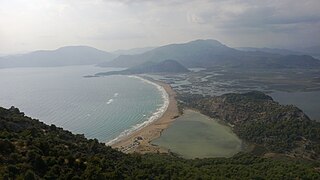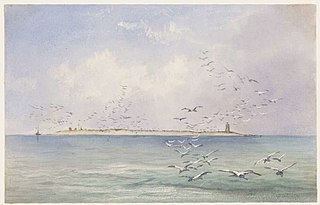
Sea turtles, sometimes called marine turtles, are reptiles of the order Testudines and of the suborder Cryptodira. The seven existing species of sea turtles are the flatback, green, hawksbill, leatherback, loggerhead, Kemp's ridley, and olive ridley sea turtles. All of the seven species listed above, except for the flatback, are present in US waters, and are listed as endangered and/or threatened under the Endangered Species Act. The flatback itself exists in the waters of Australia, Papua New Guinea and Indonesia. Sea turtles can be categorized as hard-shelled (cheloniid) or leathery-shelled (dermochelyid). The only dermochelyid species of sea turtle is the leatherback.

The olive ridley sea turtle, also known commonly as the Pacific ridley sea turtle, is a species of turtle in the family Cheloniidae. The species is the second-smallest and most abundant of all sea turtles found in the world. L. olivacea is found in warm and tropical waters, primarily in the Pacific and Indian Oceans, but also in the warm waters of the Atlantic Ocean.

The loggerhead sea turtle is a species of oceanic turtle distributed throughout the world. It is a marine reptile, belonging to the family Cheloniidae. The average loggerhead measures around 90 cm (35 in) in carapace length when fully grown. The adult loggerhead sea turtle weighs approximately 135 kg (298 lb), with the largest specimens weighing in at more than 450 kg (1,000 lb). The skin ranges from yellow to brown in color, and the shell is typically reddish brown. No external differences in sex are seen until the turtle becomes an adult, the most obvious difference being the adult males have thicker tails and shorter plastrons than the females.

The green sea turtle, also known as the green turtle, black (sea) turtle or Pacific green turtle, is a species of large sea turtle of the family Cheloniidae. It is the only species in the genus Chelonia. Its range extends throughout tropical and subtropical seas around the world, with two distinct populations in the Atlantic and Pacific Oceans, but it is also found in the Indian Ocean. The common name refers to the usually green fat found beneath its carapace, not to the color of its carapace, which is olive to black.

The Australian flatback sea turtle is a species of sea turtle in the family Cheloniidae. The species is endemic to the sandy beaches and shallow coastal waters of the Australian continental shelf. This turtle gets its common name from the fact that its shell has a flattened or lower dome than the other sea turtles. It can be olive green to grey with a cream underside. It averages from 76 to 96 cm in carapace length and can weigh from 70 to 90 kg. The hatchlings, when emerging from nests, are larger than other sea turtle hatchlings when they hatch.

Marine conservation, also known as ocean conservation, is the protection and preservation of ecosystems in oceans and seas through planned management in order to prevent the over-exploitation of these marine resources. Marine conservation is informed by the study of marine plants and animal resources and ecosystem functions and is driven by response to the manifested negative effects seen in the environment such as species loss, habitat degradation and changes in ecosystem functions and focuses on limiting human-caused damage to marine ecosystems, restoring damaged marine ecosystems, and preserving vulnerable species and ecosystems of the marine life. Marine conservation is a relatively new discipline which has developed as a response to biological issues such as extinction and marine habitats change.

The Ningaloo Coast is a World Heritage Site located in the north west coastal region of Western Australia. The 705,015-hectare (1,742,130-acre) heritage-listed area is located approximately 1,200 kilometres (750 mi) north of Perth, along the East Indian Ocean. The distinctive Ningaloo Reef that fringes the Ningaloo Coast is 260 kilometres (160 mi) long and is Australia's largest fringing coral reef and the only large reef positioned very close to a landmass. The Muiron Islands and Cape Farquhar are within this coastal zone.

Mon Repos Conservation Park is a national park containing an important turtle rookery located at Mon Repos, Bundaberg Region, Queensland, Australia, 14 kilometres (8.7 mi) east of Bundaberg. Mon Repos hosts the largest concentration of nesting marine turtles on the eastern Australian mainland and supports the most significant nesting population of the endangered loggerhead turtle in the South Pacific Ocean. Successful breeding here is critical if the loggerhead species is to survive. In far smaller numbers the flatback and green turtles and, intermittently, the leatherback turtle also nest along the Bundaberg coast.
The Key West National Wildlife Refuge is a 189,497 acre (766.867 km2) National Wildlife Refuge located in Monroe County, Florida, between Key West, Florida and the Dry Tortugas. Only 2,019 acres (8.171 km2) of land are above sea level, on several keys within the refuge. These keys are unpopulated and are also designated as Wilderness within the Florida Keys Wilderness. The refuge was established to provide a preserve and breeding ground for native birds and other wildlife as well as to provide habitat and protection for endangered and threatened fish, wildlife, plants and migratory birds.
The Jiquilisco Bay Biosphere Reserve is located on the southeast Pacific coast of El Salvador, in the department of Usulután. Jiquilisco Bay's mangrove-lined inlets and bay host the largest abundance of coastal-marine birds in the El Salvador, many of which are threatened or endangered. Over 80 species of migratory birds visit the area to feed on the bay's fish, which include species such as snook, red snapper and corvina. The natural environment of Bahia Jiquilisco has recently led to an increase in eco-tourism in the area.

İztuzu Beach is a 4.5 km long beach near Dalyan, in the Ortaca district of the Province of Muğla in southwestern Turkey. The beach is a narrow spit of land, which forms a natural barrier between the fresh water delta of the Dalyan river and the Mediterranean. It is one of the main breeding grounds for loggerhead sea turtles in the Mediterranean and is therefore often referred to as Turtle Beach. The loggerhead turtle is on the IUCN Red list of endangered animals. For this reason the beach has had a protected status since 1988 and is part of the Köyceğiz-Dalyan Special Environmental Protection Area.

Raine Island is a vegetated coral cay 32 hectares in total area situated on the outer edges of the Great Barrier Reef off north-eastern Australia. It lies approximately 620 km (390 mi) north-northwest of Cairns in Queensland, about 120 kilometres (75 mi) east-north-east of Cape Grenville on the Cape York Peninsula.

The hawksbill sea turtle is a critically endangered sea turtle belonging to the family Cheloniidae. It is the only extant species in the genus Eretmochelys. The species has a global distribution that is largely limited to tropical and subtropical marine and estuary ecosystems.

The National Marine Park of Zakynthos founded in 1999, is a national park located in Laganas bay, in Zakynthos island, Greece. The park, part of the Natura 2000 ecological network, covers an area of 135 square kilometres (52 sq mi) and is the habitat of the loggerhead sea turtle. It is the first national park established for the protection of sea turtles in the Mediterranean.
The Leatherback Trust is a non-profit organization dedicated to the conservation and study of sea turtles and freshwater turtles, with special regard for the leatherback sea turtle. The Leatherback Trust was founded in 2000 to help consolidate Las Baulas National Marine Park, one of the last major nesting site for the critically endangered leatherback turtle in the Eastern Pacific Ocean. The park protects Playa Grande, Playa Ventanas, Playa Langosta, the ocean out to 12 nautical miles, wetlands, highlands, and the coast inland to 125 m from the high tide line.

Ocypode convexa, commonly known as the golden ghost crab, or alternatively the western ghost crab or yellow ghost crab, is a species of ghost crabs endemic to the coast of Western Australia, from Broome to Perth. They are relatively large ghost crabs, with a carapace growing up to 45 mm (1.8 in) long and 52 mm (2.0 in) wide. They are easily recognisable by their golden yellow colouration. Like other ghost crabs they have box-like bodies with unequally sized claws. They also have large eyestalks with the cornea occupying most of the bottom part.

The Gnaraloo Turtle Conservation Program (GTCP) is an environmental organisation based at the Gnaraloo pastoral station and run by the Gnaraloo Wilderness Foundation, a not-for-profit organisation. The aim of the GTCP is to identify, monitor and protect the nesting beaches of loggerhead sea turtles found at two locations on the Gnaraloo coastline. These two rookeries contribute to the South-East Indian Ocean subpopulation of loggerhead turtles, with other major nesting sites for this sub-population at Dirk Hartog island and Exmouth. This is within the southern boundaries of the Ningaloo Coast marine area, a UNESCO World Heritage Site.
The Bald Head Island Conservancy (BHIC) is a non-profit organization founded November 7, 1983. BHIC's mission is barrier island conservation, preservation and education. It is located in the Smith Island Complex in Brunswick County, North Carolina, which includes Bald Head Island, Middle and Bluff Islands, all of which are bounded by the Cape Fear River and the Atlantic Ocean. BHIC sponsors and facilitates scientific research that benefits coastal communities and provides numerous recreational and educational activities for students, educators, visitors, and residents. In coordination with various organizations, partnerships and collaborations, the Conservancy has led the nation in conservation and research efforts and is uniquely poised to become a leader in Barrier Island Conservation world-wide.

The Gnaraloo Feral Animal Control Program (GFACP) operates in conjunction with the Gnaraloo Turtle Conservation Program (GTCP), a non-governmental organization whose aim is to monitor and protect sea turtle nesting beaches along the coast of Gnaraloo. Since its implementation in 2009, the GFACP has worked to reduce the impact of feral predators on sea turtle nests within these rookeries. Gnaraloo is located at the southern end of the Ningaloo Coast, a World Heritage Site. The Ningaloo Reef and surrounding coastline are home to important wildlife, including vulnerable and endangered sea turtle populations.
Lily Venizelos is a Greek conservationist.

















